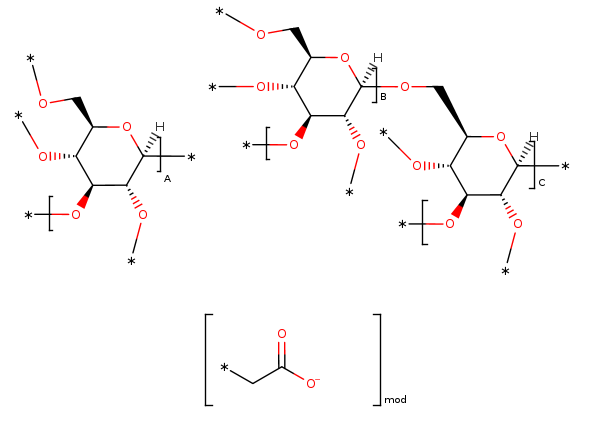| "Descrizione" by FCS777 (5554 pt) | 2023-Sep-11 19:24 |
Review Consensus: 10 Rating: 10 Number of users: 1
| Evaluation | N. Experts | Evaluation | N. Experts |
|---|---|---|---|
| 1 | 6 | ||
| 2 | 7 | ||
| 3 | 8 | ||
| 4 | 9 | ||
| 5 | 10 |
Sodium Carboxymethyl Betaglucan is a natural product, beta-glucan, a polysaccharide derived from glucose, cereals, unicellular osmofilial eukaryotic microorganisms, fungi of the type Saccharomyces cerevisiae. bacteria, yeasts, all chemically modified. It is obtained by the carboxymethylation of glucans in yeast cell walls.
The name describes the structure of the molecule
- "Sodium" refers to sodium, an alkali metal. In this context, it indicates that the compound is a sodium salt.
- "Carboxymethyl" indicates the presence of a carboxymethyl group, which is a derivative of acetic acid.
- "Betaglucan" is a polysaccharide composed of glucose units linked together by β-glycosidic bonds.
Description of raw materials used in production
- Beta-glucan. A natural polysaccharide extracted primarily from the cell walls of yeast, fungi, or cereals like oats and barley.
- Sodium chloride. Salt used as a source of sodium ions in the reaction.
- Monochloroacetic acid. The carboxymethylating agent.
Step-by-step summary of industrial chemical synthesis process
- Extraction of Beta-glucan. Beta-glucan is extracted from the natural source using solvent or physical extraction procedures.
- Carboxymethylation Reaction. The beta-glucan is reacted with monochloroacetic acid in an alkaline environment (typically in the presence of a base like sodium hydroxide) to introduce carboxymethyl groups onto the glucan.
- Neutralization. The reaction is neutralized, typically with hydrochloric acid.
- Purification. The solution is purified to remove impurities and by-products.
- Drying. Moisture is removed to yield the final product as powder or granules.
- Quality Control. The product is tested for quality and presence of carboxymethyl groups.
Industrially it appears as a water-soluble yellowish powder or colourless liquid.

What it is used for and where
Medical Applications
Dermatological Treatments. It is employed in skin care products to address conditions like eczema and psoriasis due to its anti-inflammatory and moisturizing properties.
Wound Healing. It may promote wound healing due to its anti-inflammatory and protective properties.
Cosmetics
Chemically modified beta glucan derived from active yeast, an emulsifier used to repair the epidermis and enhance natural repair processes in damaged skin. It has an anti-ageing effect as it promotes collagen synthesis and improves skin elasticity. Emulsions are thermodynamically unstable. Emulsifiers have the property to reduce the oil/water or water/oil interfacial tension, improve emulsion stability and also directly influence the stability, sensory properties and surface tension of sunscreens by modulating their filmometric performance.
- Binder agent. Ingredient that is used in cosmetic, food and pharmaceutical products as an anti-caking agent with the function of making the product in which it is incorporated silky, compact and homogenous. The binder, either natural such as mucilage, gums and starches or chemical, may be in the form of a powder or liquid.
- Viscosity control agent. It controls and adapts, Increasing or decreasing, viscosity to the required level for optimal chemical and physical stability of the product and dosage in gels, suspensions, emulsions, solutions.
Commercial Applications
Cosmetics and Skin Care. It's used for its moisturizing and anti-aging properties and can also help reduce skin reactivity and enhance its natural barrier.
Hair Products. It can be found in hair care products to moisturize and protect the scalp.
Sunscreen Products. Owing to its anti-inflammatory properties, it might be included in sunscreens to help reduce irritation caused by UV rays.
The most relevant studies on the subject have been selected with a summary of their contents:
Sodium Carboxymethyl Betaglucan studies
Typical commercial product characteristics Sodium Carboxymethyl Betaglucan
| Appearance | Light yellow powder |
| Loss on Drying | ≤5% |
| Residue On Ignition | ≤10% |
| Ash | ≤3% |
| Protein | ≤0.08% |
| Fat | ≤0.5% |
| As | ≤0.5ppm |
| Pb | ≤0.5ppm |
| Total Plate | ≤1000CFU/g |
| Yeast & Mould | ≤50CFU/g |
| Coil Group | ≤0.3 MPN/g |

- Molecular Formula (C6-H7-O5(C6-H7-O5)n)n.(C6-H7-O5)n.(C2-H2-O2)mod.Na.H
- Molecular Weight 470.42
- CAS 9050-93-5 9012-72-0
- UNII 2YGO1190AP
- EC Number 232-739-1
- DSSTox Substance ID
- IUPAC Β-D-Glucan, (1→3)-, Carboxymethyl Ether, Sodium Salt
- InChl=
- InChl Key
- SMILES
Synonyms:
- CM Glucan
- Cromoist CM Glucan
- Sodium Carboxymethyl Betaglucan Aqueous
- beta-D-Glucan, (1-3)-, carboxymethyl ether, sodium salt (ds 0.65-0.85)
- Sodium carboxymethyl-beta-(1-3)-glucan (ds 0.65-0.85)
| Evaluate |

